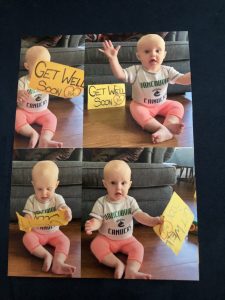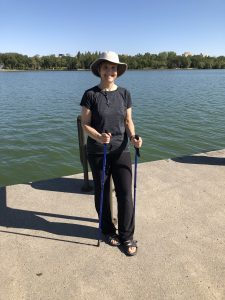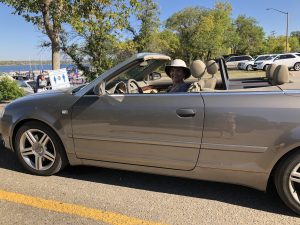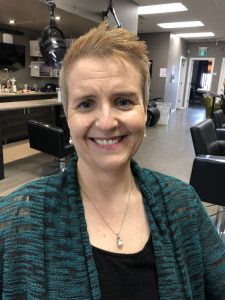5. “Walk 5 — Rest 5 — Walk 5” — Recovery, Part 1
Listen to Chapter 5
|
I will never forget what it felt like to walk into my “sanctuary,” as I like to call my bright, west-facing apartment.
The energy in the hospital had been dark (for lack of a better word), while here, at home, it was light and sparkly, the perfect environment to heal from what had admittedly been an ordeal. I was also exceedingly grateful to have my very own “butler-nurse” (as one of my sisters would later call my friend who had travelled 260 km south to join me) at my disposal for an entire week. To sleep in my own bed with approximately ten pillows to keep me comfortable was another welcome gift, in contrast to waking up with a belly that felt like I had swallowed a ten-pound dumbbell!
At the same time, I was not really surprised. The bulb — which had drained the fluid my body was producing post-surgery — and the catheter had been removed prior to my departure from the hospital. My oncologist’s nurse assured me that massaging my abdomen would bring relief, as would bowel movements. She was right, and by the afternoon I had enough energy to get into my friend’s car and go to the pharmacy, followed by a much-needed trip to the grocery store.
That evening, I also stepped on a scale, stunned to have lost ten pounds in a week. As if by magic, food began to be dropped off at my house (“You eat meat, right?”) to help me gain it back quickly. The biggest culinary treats that first week were a roasted chicken expertly prepared by my Greek colleague-friend, a huge chocolate cheesecake baked to perfection by my former department head, and a yummy vegetarian “Buddha bowl” cooked and delivered by my favourite yoga instructor.

I was also very grateful for the multitude of presents and cards sent by family members and friends from out of town, being prayed for by my church community, and receiving countless, often daily texts and e-mails of encouragement on my phone. The cutest surprise was a picture sent via snail mail that featured my seven-month-old grandniece from B.C. holding up “get well” signs her mom and aunt had specially made. “Bless their hearts,” I kept saying, highly motivated to please everyone, including myself, with a speedy recovery.
It’s a marathon, not a sprint
Every activity, big or small (like taking a shower or washing my hair) now required careful preparation as well as resting beforehand and afterwards. As a high energy person, having little to no physical strength was a real challenge. My “butler-nurse” friend suggested I keep a detailed diary to track my diet, energy level, and physical activity. “Good idea,” I replied.
The following morning, she urged me strongly to try and walk for five minutes to visit my friends who had helped me with setting up my TV and lived close by, rest for a while, and then walk back. “Bad idea,” I replied.
Handing me her partner’s walking poles which she said I could borrow for the week, she would not take no for an answer and gently pushed me out the door. “This feels like a marathon from hell,” I muttered. It would be impossible to increase my activity level by a whopping 10 minutes every week, as suggested by my oncologist.
“One day and one walk at a time,” my friend said, when I shared my concerns with her. To make it fun, she chose increasingly exciting locations in and out of town for us to be active together. To my amazement and amusement, she used a stopwatch to track my progress (“walk 5 — rest 5 — walk 5”). Had she perhaps been a German drill sergeant in a past life?

“Plan your walks according to the number of rest opportunities such as benches and steps to sit on from now on,” she suggested.
“Excellent idea,” I replied. The new walking poles which I had been gifted by the friends we had visited shortly after I got back from the hospital also helped me feel secure and look “cool” when venturing outside.
Six days after returning from the hospital, I had 35 staples removed at a medical treatment centre nearby. It did not hurt at all, unlike my friend’s departure that same afternoon. When was I going to see her again in person, I wondered, given the pandemic? And what would it feel like to return to an empty apartment? I should not have worried.
My friend had already lined up my trusted neighbour, who checked on me daily, and the friends who had helped me with setting up my new TV (“We are making supper for you tonight!”) to keep me company whenever I craved it. Using technology, family members and close friends also kept a close eye on me, and with good reason: I still needed a lot of rest, and my body promptly complained (“why is my belly hurting again?”) if I failed to comply.
Getting my work-focused brain to relax was a different matter. It was late August after all, and the fall semester was about to begin. But I soon realized that spending quality time on my balcony every day to connect with nature – were Canadian prairie skies always this blue? – helped me heal on the inside and the outside.
The diagnosis
On Tuesday, August 25, 2020, my oncologist called with the most fantastic news. Much to her surprise, the cancer — which she was able to remove completely — had not spread to the lymph nodes before the surgery. This meant only a Stage 3A diagnosis, rather than Stage 4, which indicates that the cancer has metastasized to other, distant organs of the body and may be terminal.
“Thank you to everyone who has prayed and looked out for me,” I thought, convinced that my daily creative visualization exercises had made and would continue to make a difference as well. However, since the cancer had spread so aggressively from the uterus to the ovaries, it still meant six rounds of chemotherapy, which were to begin in a month, followed by radiation therapy in the new year.
Determined to be as healthy as possible for my follow-up appointment in September, I adopted an admittedly slower and gentler rhythm during the next four weeks in recovery mode. Regular “walking dates,” as suggested by my “butler-nurse” friend on her last day in town, turned out to be absolute highlights. Each involved my beloved walking poles, special friends as well as colleagues from work (and often their dogs, if not spouses), and long, meaningful chats.
My mental health also benefitted from taking my car for a spin a couple of times a week, always carefully adjusting my seatbelt around a pillow on my belly. The drives were short, though, because sitting for long periods of time continued to be a problem. I was also not allowed to carry, push, or lift anything for six weeks after the surgery either.
Gentle stretching routines were now possible again — and most welcome. On September 1, 2020, my twin sister and I resumed our online physical activity sessions, starting with 10 to 15 minutes a day, minus ab work and anything else that would stress my body too much too soon. What a blessing to share this special time with her!
I was admittedly angry and frustrated, however, that a pandemic of all things made care visits impossible. It would have meant the world to me to welcome anyone who had offered to stay with me, specifically my three sisters, two nieces, my oldest friend from university days, and my former colleague and fellow cancer survivor who had moved to Montreal.
Instead, I was to ask my “local family” for assistance. I am happy to say that they exceeded all expectations. “How lucky am I to have so many wonderful people right here in town to help me,” I kept saying to myself, truly grateful for their continued support.
What are the odds?
Prior to the surgery, I had relied much on the support of my best friend, a local high school teacher and fellow musician. Unable to travel due to Covid-19 restrictions, we had spent a lot of quality time together in the spring and early summer, both indoors and outdoors. When she first shared her cancer diagnosis with me — I was still at the hospital — and that the doctors were working on a treatment plan for her (“I am complicated”), my heart sank. Was she going to die soon?
A Positron Emission Tomography (PET) scan finally brought clarity. It was Stage 4 Hodgkins’ Lymphoma requiring IV and oral chemotherapy; major surgery and radiation were impossible because of her pre-existing conditions.
“What are the odds,” I asked myself — and the universe — “that two best friends embark on a cancer journey at roughly the same time, and what are they to learn from it?”
In practical terms it meant that neither of us was going back to teaching in early September 2020. Never having been on medical leave before, I continued to be quite anxious about being forced to fill my time with mindful non-work-related pursuits for the next six months, if not longer. Granted, part of me was relieved about not having to run an online classroom; only one week into the semester many of my colleagues were ready to lose their minds (“I had 160 e-mails in my inbox after returning from a one-hour meeting!”).
At the same time, I feared that the insurance would not approve my long-term disability application. Over the years, I had heard my fair share of horror stories about cancer patients being forced to work throughout their treatments and return to duties too early in order to avoid losing their jobs. I also could not shake the horrible feeling that I would be penalized or stigmatized intentionally or inadvertently, now and/or in the future, for not being productive and/or active in the academic community.
And would the global pandemic be over by Christmas or linger on?
Feeling loved
In hindsight, I should have been more trusting regarding the tremendous, continuing support my colleagues would provide, regardless of location and time zone (“It’s eight hours later in Sweden, so if you can’t sleep and want to talk, give me a shout!”). My wonderful, loving church community had also been keeping me in their prayers since my surgery in August. Anticipating that playing for services was going to be out of the question for months to come, I focused on the two Sundays that were left before chemotherapy was to begin in late September.
My pastors promptly worried about me contracting Covid-19 if I rejoined their small bubble (“Will wearing masks and physical distancing be enough?”). I worried about not being able to sit on the piano bench long enough to make it through playing a 10-minute-long prelude.
During my first practice session, I realized that if I strapped a small pillow around my belly and rested before, during, and after the service, I could do it! One of my trusted substitutes had also indicated that she was willing to cover for me during my absence, for which I was incredibly grateful. Still, not playing at all felt like a minor death sentence. Could I perhaps come in on “good days” when there was nobody at the church to avoid exposure to the coronavirus?
The pastors agreed immediately, which meant more to me than can be expressed in words. Granted, there would not be a congregation and/or choir to play for. But I could still sing along to my favourite hymns — “Abide with me” and “Jesus Christ is risen today” come to mind immediately — and entertain myself with fun music for pipe organ by J. S. Bach and the many wonderful composers who have followed in his footsteps and kept organists literally on their toes.

My mental health also benefitted tremendously from being whisked off to fun locations by friends and colleagues in September. One of my favourite outings involved posing in front of the local Harley Davidson dealer — I have been known to ride motorcycles, albeit as a passenger — with my former department head who was on sabbatical; another was being chauffeured to a lovely prairie lake by my favourite yoga teacher in her snazzy Audi convertible. Life was great!
Everything changed on September 17, 2020, when my retired colleague from Montreal texted me from the hospital. “The cancer is back,” her message read.
It shocked me to the core, as I had been the first person whom she had called to share her cancer diagnosis with over a decade ago. She had been wonderfully supportive ever since I had received my diagnosis (“My favourite Barb, we will get through this together!”). The recurrence meant that there were now three of us battling cancer at the same time.
“It feels like the universe has pushed the ‘pause,’ if not ‘stop,’ button for all of us,” I said to my twin sister that evening. “I have no idea for how long.”
Treatment (and other) plans
My own life was going to get busy soon. I felt (and looked) great on September 22, 2020, when I saw my oncologist for the follow-up appointment. Due to pandemic restrictions, I could not bring anyone with me. My trusted neighbour was, however, allowed to join us on the phone and even volunteered to take minutes of everything that was said.
“How have you been?” the oncologist asked me. She was pleased with my post-surgery recovery. “That scar of yours is healing nicely!” (Maybe I would be comfortable showing it off to someone not related to me a year from now?)
The doctor’s most shocking news, though, was that only 60 to 70 percent of women with Stage 3A endometrial cancer were still alive five years later, and those who did would be susceptible to breast and colon cancer forever afterwards. My treatment plan would have to be quite aggressive as a result, and I should be prepared to deal with a multitude of side effects. That was hard to hear, especially given my excellent health prior to the cancer diagnosis.
“We will give you a lot of paperwork to go through carefully before and during your treatments, Barb,” I was told.
“No problem,” I replied, even though I secretly dreaded the idea.
The oncologist’s advice to take an entire year off (“that much?”) to focus on my health scared me; her recommendation to do what I enjoyed during that time gave me hope.
My “homework” as a patient was simple enough: no dieting, no alcohol, and no supplements besides Vitamin D. Most importantly, with a pandemic going on, my bubble needed to be super-small, and I was to wear a mask whenever I left my apartment, including when going for walks outdoors. Finally, blood work needed to be done 48 to 72 hours before each treatment, rather than on a weekly basis as had been the case with my cancer survivor friends in pre-pandemic times.
“Your wish is my command,” I said to the oncologist, and I meant it. She was the expert, and I knew instinctively that I could trust her, not unlike my students trust me.
The most memorable part of our conversation was her answer to the following question: “If I start on Friday and there are three weeks between each cycle, my last chemotherapy round would be in early January 2021, yes?”
She laughed out loud.
“Your body, not your head, will decide when it is time to move on to the next phase of your treatment, my dear,” the oncologist advised.
“Whatever that means,” I thought, rolling my eyes, albeit only in my head, and feeling sick to my stomach.
In hindsight, it turned out that she was right.
But I was still in charge until the first chemotherapy date. I remember intentionally cramming my agenda full the day before to distract myself. My top-hatted guide insisted early in the morning that I listen to a 30-minute guided (pre-)chemotherapy meditation on YouTube. The speaker sounded most convincing but nonetheless frightened me. I wept incessantly while wondering whether the chemotherapy drugs were really “healing energy medicine.” I was also skeptical that my body would indeed cooperate and instinctively know what to do to get me to wellness.
Change is in the (h)air

There were more tears when I went to see my long-time, trusted hairdresser for a super-short and super-stylish haircut before lunch. After much deliberation I had opted against investing in a hair piece. “Too expensive, too Halloweenish, and I won’t be going anywhere anyway because of the pandemic,” was my rationale. I planned to wear turbans instead, like the pretty bamboo one I had bought at the wig store the day before. The clerk had shown me several hats as well which featured buttons on either side onto which to hook one’s protective face mask. “What a great idea,” I remember thinking.
I mentioned it to my Greek colleague, one of the other female faculty members who had faced a cancer diagnosis in the past five years. A dear friend, she promptly dropped off not only multiple containers with food like she always did (“I love cooking, and you need to eat, Barb!”), but also a bag of hats she had worn while undergoing chemo. My immediate favourite was a charming, dark blue hat that would be perfect for walking outside. I made a mental note to sew buttons on it as well as on a couple of lined toques I had bought last year by the end of fall.
“You know, I covered my head every day so as not to frighten my children, who were not used to seeing me without hair,” she said. I had never thought of how my relatives and close friends would react if I embraced my baldness. Would they be shocked, or amused, or both?
“I better have a hat or scarf at the ready all the time,” I decided.
Then, I told her about how hard I had cried at the hair salon the day before my first treatment. “Who would have guessed that I was so attached to my chin-long, coloured hair?” I had said. I was also embarrassed about emptying my hairdresser’s tissue box in under 15 minutes and dreading the idea of returning any time soon for a head shave.
I eventually pulled myself together during a massage appointment in the afternoon. It was still a highly emotional visit, as the last one — during which I had declared that I did not have cancer — kept flashing through my mind. I grounded myself by shopping for groceries afterwards and distracted myself by going through insurance forms when I got home. “Thinking about the distant future is much easier than pondering the next day,” I concluded.
Finally, I met friends who were visiting from B.C. for a chat at a nearby restaurant with an outdoor patio. “That new haircut really suits you, Barb,” they commented. “You sound like you are more than ready for tomorrow.”
I would find out soon enough whether that was true or not.

